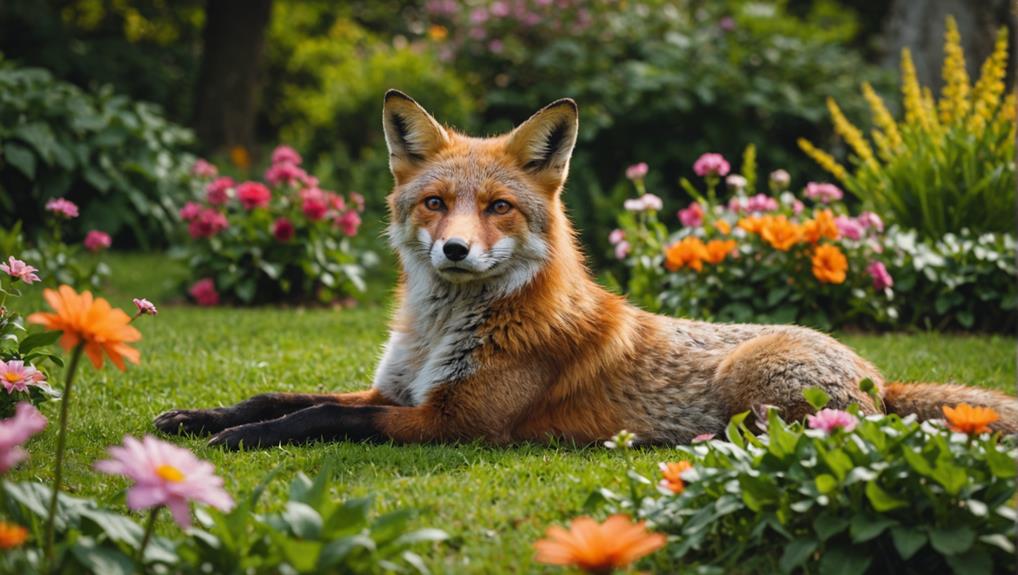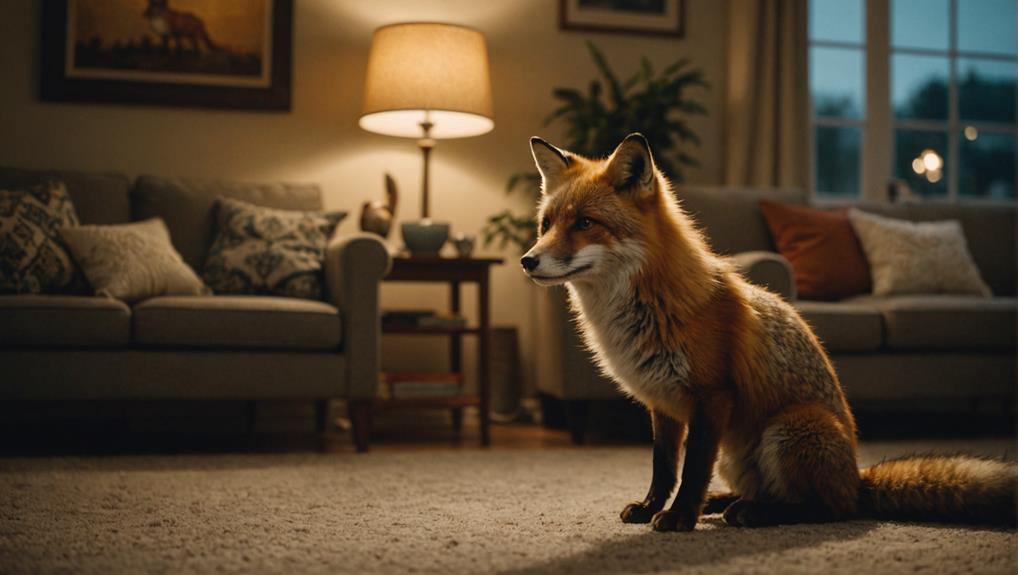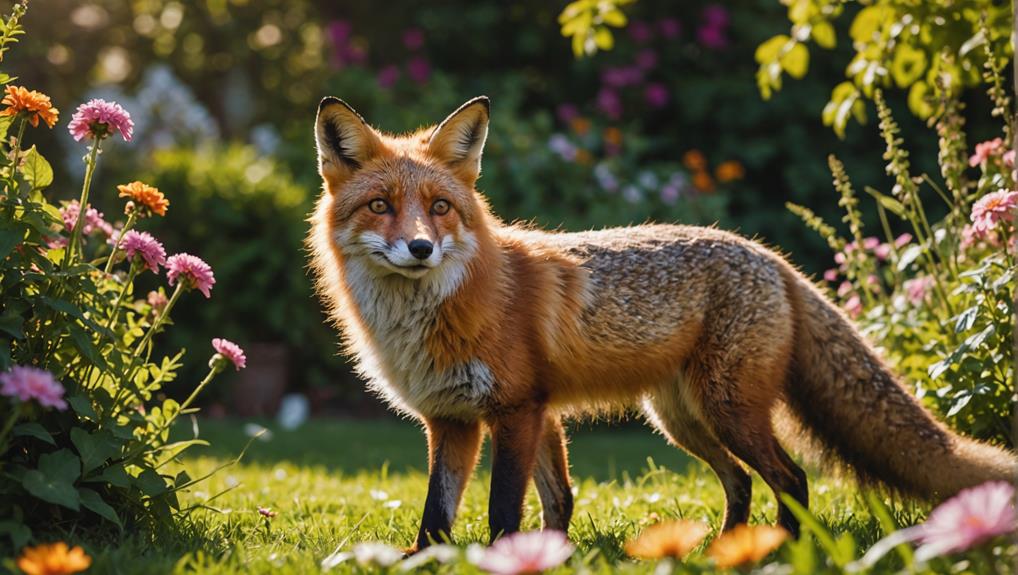Domesticated foxes, especially the charming silver fox, have a temperament that's surprisingly cuddly and playful, similar to friendly dogs. You'll notice that about 70-80% of them show these delightful traits, wagging their tails and seeking affection. However, they thrive on social interaction, so be ready to engage often; otherwise, you might find them getting into some mischievous trouble. While they can be calm and less aggressive than wild foxes, their playful nature means they need space and time for proper training. Stick around, and you might uncover even more fascinating insights about these unique pets!
Contents
- 1 Overview of Domesticated Foxes
- 2 Historical Background of Domestication
- 3 Genetic Influences on Behavior
- 4 Common Temperament Traits
- 5 Socialization and Training Needs
- 6 Challenges of Ownership
- 7 Environmental Requirements
- 8 Diet and Health Considerations
- 9 Implications for Human Behavior Understanding
- 10 Frequently Asked Questions
- 11 Final Thoughts
Overview of Domesticated Foxes
Domesticated foxes, particularly the silver fox, often resemble friendly dogs in their interactions with humans. You might notice their affectionate behavior, making them delightful companions for those who long for connection. Over generations, breeders have focused on promoting tame behavior, resulting in about 70-80% of these foxes being categorized as elite in friendliness.
Just picture a fox wagging its tail, enthusiastic to play, with floppy ears and a curled tail, looking like a cute little bundle of joy!
While domesticated foxes are generally less aggressive than their wild cousins, they can still surprise you with some unpredictable behaviors. It's crucial to remember that they need proper socialization and significant interaction with you to thrive. Without enough engagement, you might find yourself facing some behavioral problems, like boredom-fueled mischief.
Think of them as energetic toddlers—full of curiosity and a knack for getting into trouble if left unattended!
Embracing the unique personality of a domesticated fox can be incredibly rewarding. With patience and love, you'll discover just how charming these little creatures can be.
Historical Background of Domestication
Let's take a moment to explore the fascinating journey of fox domestication, which really kicked off in 1959 thanks to Dmitri Belyaev and his team.
They set out to understand how domestication works by selectively breeding silver foxes from fur farms, hoping to replicate what happened with dogs.
Over the years, they discovered that just by choosing the friendliest foxes to breed, they could create a whole new population with adorable traits that mirrored our beloved canine companions!
Belyaev's Domestication Experiment
When Dmitri Belyaev launched his silver fox domestication experiment in 1959, he aimed to uncover the genetic changes linked to tameness and selective breeding for friendly traits. Conducted at the Institute of Cytology and Genetics in Siberia, Belyaev's goal was to replicate the domestication of dogs using foxes. He focused on breeding the calmest foxes from fur farms, and guess what? This experiment turned out to be groundbreaking!
Over generations, the results were astonishing. The number of friendly foxes rose dramatically, from just 18% in the 10th generation to around 70-80% in later generations. It's like watching a shy kid blossom into a social butterfly!
By the sixth generation, these domesticated foxes began to show dog-like behaviors, wagging their tails and even flaunting juvenile features.
Though Belyaev died before seeing the full impact of his work, his experiment laid the groundwork for understanding the fox genome and its ties to behavior. Despite the political challenges of the time, his resilience and passion helped shine a light on the magic of domestication, showing us just how interconnected we all are.
Who knew foxes could be so friendly?
Evolution of Tame Traits
The evolution of tame traits reveals the remarkable journey of animal domestication, where selective breeding has shaped behaviors and physical characteristics over generations.
You might be surprised to learn that the silver fox domestication experiment, started in 1959, showcased just how quickly behaviors can change. Through careful selection of the tamest foxes, researchers observed notable shifts in behavior in just six generations.
Imagine a world where:
- Foxes greet you like long-lost friends, tails wagging.
- Their floppy ears and curled tails make them irresistibly cute.
- A calm demeanor replaces the usual skittishness, making them more like our beloved dogs.
Genetic Influences on Behavior

Numerous studies reveal that genetics play an essential role in shaping the behavior of domesticated foxes. In the fascinating experiment in Novosibirsk, researchers selectively bred foxes for tameness. Within just six generations, these domesticated foxes began to behave like friendly dogs, showcasing how powerful genetic influences can be.
It's not just one gene at play; over a hundred genes have been linked to behavioral modifications. This means multiple genes work together to create the social behaviors we see in these charming creatures.
Interestingly, tame foxes show juvenile traits, like floppy ears and curled tails, which are part of what scientists call the domestication syndrome. This is a bit like when we see baby faces in adult animals—cute, right?
Also, domesticated foxes have lower adrenaline levels compared to their wild relatives, making them calmer and less aggressive.
The ongoing research aims to decode the fox genome, helping us better understand the genetic basis of behavior. This knowledge could spill over into our understanding of animal—and even human—behavior. So, who knew that a little fox could teach us so much about ourselves?
Common Temperament Traits
Domesticated foxes exhibit a range of temperament traits that make them surprisingly similar to friendly dogs. You'll notice their playful nature and a friendly demeanor that invites interaction.
These tame foxes are known for their charming behaviors, such as:
- Wagging their tails excitedly when they see you
- Showcasing curiosity by exploring their surroundings
- Engaging in playful antics that can brighten your day
With behavioral modifications arising from generations of selective breeding, about 70-80% of domesticated silver foxes display endearing traits that make them a joy to be around.
Unlike their wild relatives, tame foxes have lower aggression levels and calmer temperaments, which means less drama in your life—thank goodness for that!
However, it's important to remember that they still have instincts. While they're friendly and loving, they might mark their territory occasionally.
This little quirk reminds us that consistent training and socialization are essential to manage their temperament effectively. So, if you're considering welcoming one of these delightful creatures into your life, get ready for a companion that's as playful and affectionate as any dog, with a touch of wild charm!
Socialization and Training Needs

Welcoming a domesticated fox into your home means understanding its socialization and training needs from the start. These charming pet foxes thrive on interaction, so it's essential to engage them early. Without proper socialization, they might develop behavioral issues that could stress both you and your furry friend.
Remember, positive reinforcement works wonders! Harsh training methods can scare them and lead to unwanted aggression.
Potty training can be a bit tricky due to their instinctual marking habits. But don't worry! Early and consistent efforts can yield success. You'll want to stay patient and celebrate the small victories.
Regular engagement is also imperative; bored foxes can turn into little tornadoes of mischief! Aim for several hours of dedicated attention each day to keep them happy and healthy.
Lastly, be prepared for the strong musky odor that comes with your new companion. Maintaining a clean environment is fundamental, and traditional cleaning methods mightn't do the trick.
Embrace the challenge, and you'll find that your domesticated fox can bring a lot of joy—and maybe a little chaos—into your life!
Challenges of Ownership
Owning a domesticated fox can be a wild adventure, but it comes with its own set of challenges.
You'll need to prepare for some quirky behaviors that might leave you scratching your head, plus foxes require plenty of space to roam and play.
With a significant time commitment needed for socialization and training, you'll want to think twice before bringing one of these playful critters into your home—unless you're ready for some chaos and lots of love!
Behavioral Traits to Expect
Expect a mix of friendly demeanor and unpredictable behavior when you bring a domesticated fox into your home. These charming creatures can be both affectionate and a tad wild, making them a unique choice as pets.
Remember, while they might wag their tails with excitement, their instincts can sometimes shine through.
Here are a few behavioral traits you might encounter:
- A strong marking instinct that can lead to potty training challenges.
- Moments of playful destruction when bored—think chewed furniture or torn-up cushions.
- A distinct, musky odor that seems to linger, no matter how much you clean.
While foxes can be tame and friendly, they may also display aggressive tendencies if not socialized properly. Regular interaction with you and other pets is essential for reducing behavioral issues.
Their need for engagement is significant; without it, they may resort to mischief.
Space and Environment Needs
Creating a suitable environment for a domesticated fox can be one of the more challenging aspects of ownership.
You'll need to provide a secure enclosure that's at least 100 square feet, with fencing strong enough to withstand curious little paws. A 12-gauge thickness is crucial to keep your fox safe and prevent daring escapes.
In this space, aim for a housing arrangement of about 10×20 feet. Foxes need room to roam and play—without it, they might turn to mischief as a way to cope with boredom.
Don't forget about the enclosure design! A full top and bottom will guarantee safety, while a double gate entry adds an extra layer of security.
When your fox is indoors, toddler-proofing your environment is key. These little furballs are curious and can get into everything!
Regular engagement is essential, too. You'll want to spend several hours each day interacting with your fox to keep them stimulated and content.
After all, a happy fox makes for a happy owner! So, be prepared to create a lively, secure, and engaging space that meets your fox's needs.
Time Investment Required
Investing time in a domesticated fox is essential for its well-being and happiness. These clever little creatures need several hours each day for exercise, interaction, and enrichment to keep boredom at bay. Remember, a bored fox can lead to chaos—and we don't want your favorite shoes turned into chew toys!
Here's what you can expect regarding time commitment:
- Training and socialization challenges: House training can be tricky due to their instinctual behaviors, so patience is key.
- High energy levels: Daily playtime is a must! These energetic furballs thrive on exploration and activity.
- Regular grooming: Just like long-haired dogs, they shed seasonally and need brushing to stay comfortable and avoid tangles.
If you're willing to put in the effort, you'll find that the rewards are immense. A well-cared-for fox can be a loving companion, full of personality and charm.
Just be prepared to invest your time and energy, and you'll create a happy, fulfilling life for both of you. After all, who wouldn't want to share their home with a little bundle of joy that's just a bit more "fox-tastic"?
Environmental Requirements

Providing a safe and stimulating environment for domesticated foxes is essential for their overall well-being.
These clever little creatures need an outdoor enclosure of at least 100 square feet to run around and explore. You'll want to use materials like welded wire over chain link, ensuring the enclosure has a full top and bottom to keep those crafty foxes from escaping! A double gate entry system is a wise addition, as it adds an extra layer of security during your visits.
But it's not just about safety; environmental enrichment is crucial, too! Foxes are playful and curious, so make sure to provide various toys and hiding spots. Think of it as their very own adventure park!
You'll also need to dedicate several hours each day to interact with them. After all, these social animals thrive on companionship and playtime, so get ready to bond and have some fun. Your efforts won't only prevent boredom but also help your foxes grow into well-adjusted pets.
With the right environment and your dedicated attention, your foxes will flourish, bringing joy and excitement into your life!
Diet and Health Considerations
A well-rounded diet is vital for your domesticated fox's health and longevity. These clever little creatures need a balanced menu, so you'll want to make sure they're getting the right nutrients. Think of their meals as a colorful plate that includes:
- Raw meat and organs for protein and energy
- Fresh fruits and veggies for vitamins and minerals
- Taurine supplements for brain health and function
Feeding domesticated foxes grain-free dog food twice daily is a good rule of thumb, but you should adjust based on their size to keep them fit.
However, steer clear of feeding them pork, beef, or cooked bones—those can pose health risks, like pesky parasites.
Regular vet check-ups are key since these foxes can catch canine diseases. Think of it as a little spa day for your furry friend!
After all, staying up to date on vaccinations and parasite prevention is part of your commitment to their well-being. Some owners even choose freeze-dried raw dog kibble as a protein alternative.
Implications for Human Behavior Understanding

How can studying domesticated foxes enhance our understanding of human behavior? Well, it turns out that these charming creatures can teach us a lot, especially when it comes to social behaviors and autism spectrum disorders. By observing domesticated foxes, researchers found parallels to some behavioral traits seen in humans.
For example, tame foxes behave like playful puppies, enthusiastic for interaction. This can inspire new strategies for socialization in human therapies. Plus, the inability of some foxes to recognize human intent mirrors similar traits in individuals with autism, emphasizing the need to understand emotional cues.
Here's a quick look at how fox behavior connects with human social behaviors:
| Fox Behavior | Human Parallel |
|---|---|
| Enthusiasm for social interaction | Engaging in social therapies |
| Difficulty recognizing intent | Challenges in understanding emotions |
| Playful nature | Importance of nurturing social skills |
Frequently Asked Questions
What Is the Behavior of a Domesticated Fox?
When considering a domesticated fox's behavior, you'll notice its adaptations for friendliness alongside wild instincts. Effective socialization techniques will help you manage its unique traits and encourage positive interactions, balancing wild vs. domesticated behavior.
Are Domesticated Foxes Friendly?
Domesticated foxes are indeed friendly! With their playful tendencies and enthusiasm for friendly interactions, implementing socialization strategies helps nurture their affectionate nature, creating a delightful bond that enriches both your life and theirs.
What Is the Personality of a Fox as a Pet?
When considering a fox as a pet, you'll find they require dedicated fox care, consistent fox training, and regular fox socialization. Their playful personalities can bring joy, but managing their needs is essential for harmony.
What Is Fox Temperament?
You'd think a fox is just a furry companion, but their temperament's a mix of social interactions and wild instincts. Training can be a challenge, requiring patience and commitment to foster a well-adjusted pet.
Final Thoughts
Owning a domesticated fox can feel like having a quirky, furry companion straight out of a storybook. They're playful and affectionate, but they also come with unique challenges. Just like in a fairy tale, you'll need patience and understanding to truly bond with them. If you're ready for the adventure, these clever little creatures can bring joy and a touch of wildness to your life. So, are you up for a little magical mischief?














